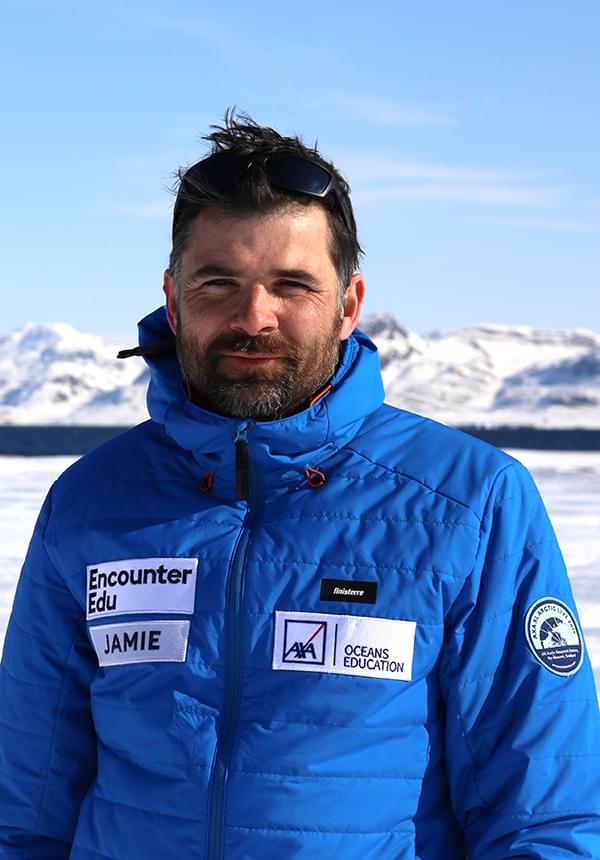
Keeping warm in the Arctic
Due to the COVID-19 (Coronavirus) outbreak, AXA Arctic Live 2020 live lessons will be delivered as a virtual event, with speakers joining from where they are, rather than from the UK's Arctic Research Station.
This live lesson activity is a fun way of learning about how explorers survive the extreme conditions in the Arctic. Students will investigate different materials and compare how they perform as insulators. While waiting to measure and record the results, students will also be encouraged to think about how Arctic animals have evolved to keep warm. They can pretend to be an Arctic animal and find out whether a layer of fat is a way of keeping warm in the Arctic, by trying on a pair of blubber gloves.
Preparation
Arrange students into groups and organise all resources needed for the experiment, found here.
For the Blubber Gloves activity, you will do this activity as a class. Organise the resources, so they are readily available during the session for the activity to be successful. The resources you will need are: a large container or bucket, lots of ice, a timer (optional), fat, such as margarine or animal equivalent such as suet, butter or lard, plastic bags or rubber gloves and towels for drying off hands.
Session steps
1. Introduction (5 mins)
Jamie will open the session with a welcome and brief introduction to the expedition and any shout-outs to registered classes. Jamie will then proceed to speak about the climate in the Arctic and staying warm. He will explain briefly that they want their clothing to be insulating and question which material may be most insulating. Jamie will go on to speak about how a fair test to compare materials can be set-up.
In this activity, students will investigate clothing materials and consider how other organisms survive without clothing in the extreme Arctic environment.
2. Subject knowledge (5 mins)
Jamie will introduce some of the organisms that live in the extreme Arctic environment and how they have adapted to be able to survive in this extremely cold weather.
During this time students to get into their allocated groups and set up their experiments.
3. Activity time (25 mins)
Jamie will complete the steps for the Keeping Warm investigation.
Jamie will discuss his clothing in more detail and talk about the adaptations that other organisms have for staying warm. Jamie will then introduce a way for students to experience what it might be like to have a layer of blubber for keeping warm. Jamie will then perform the Blubber Gloves activity.
Jamie will then discuss his results, you may find results will depend on the materials used, however, expect ‘fluffy’ materials to be better insulators as they trap air.
4. Q&A and conclusion (10 mins)
After completing the activity Jamie will be able to answer pre-submitted questions and take part in the live chat. At the end of the broadcast, Jamie will suggest some other activities you might like to try and what's coming up in the rest of Arctic Live 2020.
Speakers

Jamie Buchanan-Dunlop
Executive Director, Encounter Edu
Brought to you by



With the support of




Keeping warm in the Arctic
Due to the COVID-19 (Coronavirus) outbreak, AXA Arctic Live 2020 live lessons will be delivered as a virtual event, with speakers joining from where they are, rather than from the UK's Arctic Research Station.
This live lesson activity is a fun way of learning about how explorers survive the extreme conditions in the Arctic. Students will investigate different materials and compare how they perform as insulators. While waiting to measure and record the results, students will also be encouraged to think about how Arctic animals have evolved to keep warm. They can pretend to be an Arctic animal and find out whether a layer of fat is a way of keeping warm in the Arctic, by trying on a pair of blubber gloves.
Preparation
Arrange students into groups and organise all resources needed for the experiment, found here.
For the Blubber Gloves activity, you will do this activity as a class. Organise the resources, so they are readily available during the session for the activity to be successful. The resources you will need are: a large container or bucket, lots of ice, a timer (optional), fat, such as margarine or animal equivalent such as suet, butter or lard, plastic bags or rubber gloves and towels for drying off hands.
Session steps
1. Introduction (5 mins)
Jamie will open the session with a welcome and brief introduction to the expedition and any shout-outs to registered classes. Jamie will then proceed to speak about the climate in the Arctic and staying warm. He will explain briefly that they want their clothing to be insulating and question which material may be most insulating. Jamie will go on to speak about how a fair test to compare materials can be set-up.
In this activity, students will investigate clothing materials and consider how other organisms survive without clothing in the extreme Arctic environment.
2. Subject knowledge (5 mins)
Jamie will introduce some of the organisms that live in the extreme Arctic environment and how they have adapted to be able to survive in this extremely cold weather.
During this time students to get into their allocated groups and set up their experiments.
3. Activity time (25 mins)
Jamie will complete the steps for the Keeping Warm investigation.
Jamie will discuss his clothing in more detail and talk about the adaptations that other organisms have for staying warm. Jamie will then introduce a way for students to experience what it might be like to have a layer of blubber for keeping warm. Jamie will then perform the Blubber Gloves activity.
Jamie will then discuss his results, you may find results will depend on the materials used, however, expect ‘fluffy’ materials to be better insulators as they trap air.
4. Q&A and conclusion (10 mins)
After completing the activity Jamie will be able to answer pre-submitted questions and take part in the live chat. At the end of the broadcast, Jamie will suggest some other activities you might like to try and what's coming up in the rest of Arctic Live 2020.
Speakers

Jamie Buchanan-Dunlop
Executive Director, Encounter Edu
Brought to you by



With the support of





